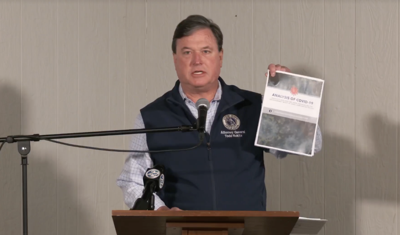Indiana Attorney General Todd Rokita is accusing public health entities across the state of submitting “faulty” and “unsound” data when it came to COVID-19’s death toll and positivity rate.
Rokita said a report he commissioned — although apparently compiled by his office — “aims to educate the public about the state’s fundamental failures at the time to meet the challenges of a global pandemic with the best possible responsive action. But more importantly, this is not about who is right. … It is about accountability but it’s also about … not letting this happen again.”
The state’s governor — a Republican, as is Rokita — panned the attorney general’s document and reaffirmed his support for the state’s pandemic efforts.
“I have very little thoughts about his report,” said Gov. Eric Holcomb. “I stand by our accurate Department of Health reported numbers. They are accurate, and I can’t speak to where he found his information. [He] certainly didn’t work with the Department of Health or with our office,” Holcomb said.
A Saturday conservative political rally near South Bound coincided with the four-year anniversary of COVID-19 lockdowns.
On Monday, Rokita published a 29-page “Analysis of COVID-19”, which appears to be a news release from his office and does not appear to include independent input from data scientists, medical professionals nor name any contributing individuals — or relevant credentials.
Additionally, it tells politicians that “we’re watching” to avoid a repeat of COVID-19, Rokita said, so “that they do not use inflated death counts and unsound positivity rates to enforce detrimental lockdowns, which have caused harm to Hoosiers’ mental and physical well-being.”
The document appears largely to be a follow-up to a WSBT interview on television in which Rokita questioned the Indiana Department of Health’s methodology for reporting COVID-19 positivity rates. The agency didn’t respond to a request for comment.
Asked if he thought there was any validity to Rokita’s document, Holcomb quickly said, “Zero.”
Rokita’s release
At the Saturday rally, Rokita largely read from his introduction to the news release, which includes several footnotes to media reports. He re-litigated actions taken during the COVID-19 pandemic, specifically a shutdown period in 2020.
Various research has affirmed the lingering toll of the pandemic, including learning losses and ongoing problems with chronic absenteeism, but others note that the youth mental health crisis started surging even before COVID-19.
Rokita said his office reviewed nearly 145,000 death records, concluding that the state “over-reported COVID-19 deaths by 10.9% in 2020, 7% in 2021 and 12.5% in 2022” by counting deaths that he said should have been attributed to accidents, drownings and overdoses.
Rokita urged IDOH to review death certificate data, noting that his office didn’t have access to medical files. The office appears to have compared COVID-19 death counts reported by one arm of the IDOH with IDOH’s vital records database.
But the document acknowledged it was difficult to compare since it “could not match a death certificate to an individual” from the Management Performance Hub, which maintains datasets for the state.
Any difference in numbers between the two sets was reported as a “variance.”
The provocative release also accuses government officials of engaging in “massive censorship” “aimed at pressuring all-too-obliging social media companies to silence voices at odds with the government’s pandemic propaganda.”
A key point of contention by Rokita was the method used to calculate positivity rates, which at one point were used to place limits on gathering sizes to curb the spread of the highly contagious virus.
He accused the state of inflating such rates, and thus delaying “re-openings” for Hoosiers in contrast to reports from health researchers from the Indiana University Fairbanks School of Public Health, which he said reported lower positivity rates in a randomized survey.
The school declined to comment on Rokita’s news release.
Positivity rates relied heavily on the number of people testing, meaning Hoosiers displaying symptoms were more likely to test and some — such as those in high exposure fields who were testing regularly — were counted multiple times.
That, Rokita said, inflated the positivity rate.
He went on to make pointed criticisms about remarks from Holcomb, with whom he has frequently sparred with, that the state’s executive leader had “no regrets” when it came to the state’s handling of COVID-19.
The concluding graphs of the release recall the 2021 comments from Rokita to South Bend TV station WSBT, where he first publicly questioned the state’s COVID-19 positivity rate calculations.
“Almost three years later, many of the concerns raised by (Rokita) and healthcare professionals remain unaddressed by public health officials,” the Rokita report read. “After considerable investments of taxpayer dollars in COVID-19 relief, the inconsistencies and inaccuracies outlined in this report still exist and (the Office of Attorney General) is unaware of attempts by public health officials to reconcile them.”
The final page of the report calls for the $225 million spent to shore up the state’s beleaguered public health system to be diverted to his recommendations instead. Those dollars are meant to assist with county-level public health departments, including smoking cessation efforts, improving infant and maternal mortality rates and lead abatement.
Indiana Capital Chronicle Senior Reporter Casey Smith contributed to this story. This and other Capital Chronicle articles are available at indianacapitalchronicle.com.

































Commented
Sorry, there are no recent results for popular commented articles.